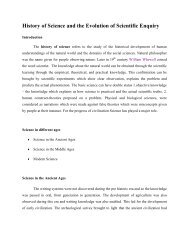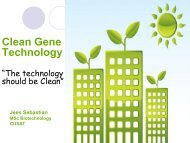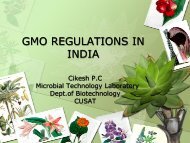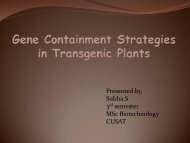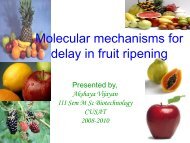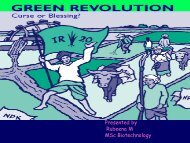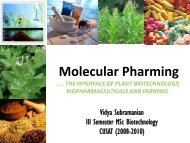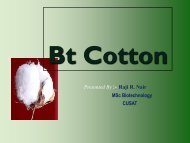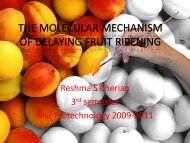Metabolic Engineering of Carbohydrates - (CUSAT) â Plant ...
Metabolic Engineering of Carbohydrates - (CUSAT) â Plant ...
Metabolic Engineering of Carbohydrates - (CUSAT) â Plant ...
You also want an ePaper? Increase the reach of your titles
YUMPU automatically turns print PDFs into web optimized ePapers that Google loves.
<strong>Metabolic</strong> <strong>Engineering</strong><br />
<strong>of</strong><br />
<strong>Carbohydrates</strong><br />
By<br />
Rajesh K V<br />
III Sem MSc. Biotechnology
Genetic modifications <strong>of</strong> <strong>Plant</strong><br />
carbohydrate metabolism<br />
• Molecular farming <strong>of</strong> carbohydrates<br />
• <strong>Plant</strong>s produce a wide range <strong>of</strong> commercially important<br />
carbohydrates<br />
• Cellulose and starch<br />
- most abundant<br />
- Some biotechnological effort towards the improvement <strong>of</strong><br />
yield and quality
Considerations when modifying <strong>Plant</strong><br />
carbohydrate metabolism<br />
I. SOURCE – SINK INTERACTIONS<br />
• Ensure the adequate translocation <strong>of</strong> sucrose from source to<br />
sink tissues ( meristems , immature leaves, seeds, roots)<br />
• is essential to ensure the optimal plant growth and crop yield<br />
• For eg.<br />
Introduction <strong>of</strong> antisense construct <strong>of</strong> the sucrose transporter<br />
cDNA to potato plants<br />
- reduction in the expression <strong>of</strong> the sucrose transporter (SUT1)<br />
RNA<br />
- hence reduction in the export <strong>of</strong> carbohydrates from the<br />
source leaves<br />
- reduced growth, root development & tuber yield.
II. Flexibility <strong>of</strong> the metabolism<br />
• A characterisitic feature <strong>of</strong> plant metabolism,<br />
is that alternative routes to the same product<br />
<strong>of</strong>ten exist within the same tissue that makes<br />
it harder to manipulate<br />
• attempts to change flux through one pathway<br />
may be compensated by changes in another.
III. Sugar- Induced Signaling In <strong>Plant</strong>s<br />
• <strong>Carbohydrates</strong> such as glucose, fructose,& sucrose also<br />
function as signaling molecules<br />
• many genes have been characterized <strong>of</strong> which transcription<br />
is regulated by sugars<br />
-Glucose induces Patatin gene expression<br />
-Sucrose – chalcone synthase<br />
• Sugars can also repress the gene transcription<br />
-glucose – Chlorophyll a/b binding protein<br />
-fructose- RuBp carboxylase smaller subunit
IV. Expression Of Introduced Genes<br />
Promotor used – CaMV 35S type<br />
constitutively expressed in all tissues throughout<br />
development<br />
the expression <strong>of</strong> a certain protein in particular cell<br />
types might have detrimental effects<br />
For eg;<br />
Constitutive expression <strong>of</strong> E.coli enzyme<br />
pyrophosphorylase in tobacco or potato stimulates<br />
sucrose synthesis.
• To evade the “translocation” problems<br />
the ectopic expression <strong>of</strong> genes should be<br />
controlled either by<br />
i) using a tissue specific promoter<br />
Eg; granule-bound starch synthase promoter<br />
ii) a developmentally regulated promoter<br />
iii) a promoter which can be induced<br />
(pathogen related promoter PR-1a).
Molecular pharming <strong>of</strong> <strong>Carbohydrates</strong>
STARCH
• The principal storage carbohydrate in plants<br />
• A major product <strong>of</strong> photosynthesis<br />
•<br />
• Representing 65-80% <strong>of</strong> the dry weight in<br />
cereals and potato tubers<br />
• In USA and Europe, about 70% <strong>of</strong> the starch<br />
produced is used for a variety <strong>of</strong> industrial<br />
purposes<br />
• With only 30% is used for human consumption and<br />
animal feed.
Industrial purposes
Starch biosynthesis<br />
• occur in the plastids <strong>of</strong> leaves & in amyloplasts<br />
<strong>of</strong> storage organs<br />
• Upon entry <strong>of</strong> sucrose in the sink cells , sucrose<br />
is cleaved by sucrose synthase & converted to<br />
Glu-1-P which can be used for the synthesis <strong>of</strong><br />
ADP-glucose, the major substrate for starch<br />
biosynthesis<br />
• reaction is catalysed by ADP –glucosepyrophosphorylase
Manipulation Of Starch Content<br />
• The amount <strong>of</strong> starch deposited in the potato<br />
tuber is affected by;<br />
- the rate <strong>of</strong> photosynthesis<br />
-the translocation <strong>of</strong> photoassimilates<br />
-the sink strength (capacity to attract<br />
photoassimilates).
Genetic Modification Of Starch<br />
Structure & Properties<br />
• The physical properties <strong>of</strong> starch granules are<br />
mainly determined by;<br />
-granule size<br />
- lipid content<br />
- amylose content<br />
- chain length<br />
- degree <strong>of</strong> branching<br />
- amylase/amylopectin ratio
• The physical properties <strong>of</strong> the strach granules<br />
can be modified by;<br />
-altering the expression <strong>of</strong> endogenous<br />
enzymes<br />
- by introduction <strong>of</strong> foreign genes.
GENETIC MODIFICATION OF STARCH<br />
• genes encoding the main enzymes <strong>of</strong> starch<br />
biosynthesis have been cloned & used to<br />
produce transgenic lines.
Granule-bound starch synthase I<br />
genes(GBSS I)<br />
• the main enzyme <strong>of</strong> amylose biosynthesis<br />
• increased activity <strong>of</strong> GBSS I is expected to<br />
increase the amylose content <strong>of</strong> starch, while<br />
• suppression <strong>of</strong> GBSS I should enhance the<br />
amylopectin content
Amylose-free or “waxy” starch<br />
• Produced in potato<br />
• Suppression <strong>of</strong> GBSS I activity by antisense<br />
RNA technology<br />
• the first successful genetic modification <strong>of</strong><br />
starch reported in 1991.
Soluble Starch Synthase (SSS)<br />
• main enzyme <strong>of</strong> amylopectin biosynthesis<br />
• has 2 is<strong>of</strong>orms - SSS I & SSS II<br />
• A freeze-thaw stable potato starch has been<br />
created by simultaneous down regulation <strong>of</strong><br />
all the 3 starch synthases, viz. GBSS I, SSS I &<br />
SSS II, genes using anti sense RNA technology.<br />
• yields an amylose - free short chain<br />
amylopectin.
Starch Branching Enzyme (SBE)<br />
• Enzyme required for amylopectin biosynthesis<br />
• suppression should reduce the amount <strong>of</strong><br />
amylopectins.<br />
• by using antisense constructs <strong>of</strong> the genes<br />
concerned.<br />
• resulted in a very high amylose starch
Manipulations Of Starch Metabolism<br />
• Starch & its derivatives have various uses- in<br />
making paper products, baking and other food<br />
uses, textile manufacture, paints, rubbers etc.<br />
• Many <strong>of</strong> the starch derivatives are obtained by<br />
post- harvest modification <strong>of</strong> the isolated<br />
starch<br />
- is expensive & environmentally polluting<br />
Transgenic production is cheaper by cost
CYCLODEXTRINS
• One type <strong>of</strong> high value product that could be<br />
made from starch<br />
• These compounds are typically 6, 7 or 8<br />
membered rings comprising glucopyranose<br />
subunits attached in α (1-4) linkage<br />
• normally produced by bacterial fermentation<br />
<strong>of</strong> maize starch<br />
• Used for solubilization <strong>of</strong> hydrophobic<br />
pharmaceuticals such as steroids
cyclodextrin
• Only a single attempt has been reported to<br />
produce cyclodextrins(1991)<br />
• Gene construct;<br />
-a bacterial cyclodextrin glycosyl transferase gene –<br />
from Klebsiella pneumoniae<br />
-a plastid targeted sequence<br />
- promotor from the patatin gene<br />
Patatin is a protein that accumulates in potato tubers.
• the promoter directs high levels <strong>of</strong> expression<br />
in the tubers <strong>of</strong> transgenic potatoes<br />
• Transformation <strong>of</strong> potatoes with this construct<br />
resulted in very little conversion (0.001-0.01%)<br />
<strong>of</strong> starch to cyclodexrins.<br />
• It was concluded that the insoluble starch<br />
granules may have been inaccessible to the<br />
bacterial enzyme, or that the enzyme became<br />
trapped in the growing granule
POLYFRUCTANS
• are soluble polymers <strong>of</strong> fructose<br />
• are synthesized& stored in the vacuole<br />
• another carbohydrate targeted for production<br />
in transgenic plants<br />
• Have a typical structure <strong>of</strong> glu-fru-(fru) n<br />
• Most abundant storage carbohydrates in<br />
plants after starch and sucrose<br />
• Inulin is water-soluble
Levan<br />
Inulin
• Inulin:<br />
-the major storage carbohydrate found in<br />
bulbs <strong>of</strong> onions, storage roots <strong>of</strong> chicory<br />
and Jerusalem artichoke<br />
- formed by (1→2β)linkages<br />
• Levans:<br />
- present in leaves and stems <strong>of</strong><br />
cereal crops such as wheat<br />
- possess (6→2β) linkages<br />
Levan
Biosynthesis <strong>of</strong> Fructans<br />
• two stage process<br />
• The first step:<br />
transfer <strong>of</strong> fructose from a donor sucrose<br />
molecule to an acceptor sucrose molecule to<br />
form kestose<br />
the enzyme sucrose-sucrose<br />
fructosyltransferase (SST)<br />
• 2 G-F → G-F-F + G
• The Second step:<br />
• kestose (GFF or GF2) acts as the fructose<br />
donor to the growing fructan chain,<br />
• via fructanfructan fructosyltransferase<br />
activity & a sucrose molecule is recycled<br />
• G-F-(F) n + G-F-F → G-F-(F) n+1 + G-F
Genetic manipulation:<br />
• A number <strong>of</strong> transgenic plants producing<br />
polyfructans have been developed<br />
• In earlier experiments the sacB gene <strong>of</strong> B.<br />
subtilis or B. amyloliquifaciens which encodes<br />
a levan-sucrase catalyzing a 6-2β linkage was<br />
transformed into maize, tobacco, potato,&<br />
sugarbeet.<br />
• sacB gene was modified with a vacuolar<br />
targeting sequence from the yeast<br />
carboxypeptidase gene(cpy).
Genetic manipulation:
In Maize;<br />
• B. amyloliquifaciens sacB gene was<br />
expressed in the endosperm under the<br />
control <strong>of</strong> a zein promoter<br />
• The enzyme was targeted to vacuole <strong>of</strong><br />
the endosperm cells using two different<br />
vacuolar targeting sequences.<br />
• In one construct the sweet potato<br />
sporamin signal peptide & vacuolar<br />
targeting sequences were fused to the N-<br />
terminal end <strong>of</strong> the enzyme.
• In the other , the barley lectin signal<br />
peptide was fused to the N-terminal end & the<br />
barley lectin vacuolar targeting sequence was<br />
fused to the C-terminal end <strong>of</strong> the enzyme<br />
• Short olig<strong>of</strong>ructans (GF2, GF3 &GF4) have been<br />
produced in sugarbeet using a gene encoding<br />
the 1-SST enzyme from Jerusalem artichoke.<br />
• This enzyme catalyses the production <strong>of</strong> not<br />
onlyGF2(ketose) but also GF3 &GF4.
Jerusalem artichoke
• Larger inulin molecules have been produced in<br />
potato tubers transformed with the 1-SST & 1-<br />
FFT genes <strong>of</strong> globe artichoke<br />
• It has been possible to produce inulin <strong>of</strong> the<br />
neoseries in chicory by transformation with<br />
the barley 6-SFT gene to produce branched<br />
fructans <strong>of</strong> the graminan type.<br />
• The production <strong>of</strong> fructans in transgenic<br />
plants has been critically reviewed by<br />
Cairns(2003).
TREHALOSE
• A non-reducing di-saccharide<br />
• Plays its part as an energy source.<br />
• Produced in some plants and micro-organisms,<br />
<strong>of</strong>ten in response to osmotic stress.<br />
•<br />
• Potential target for gene manipulation <strong>of</strong><br />
tolerance <strong>of</strong> abiotic stresses that create<br />
water deficit.
Genetic manipulation:<br />
• Genes for the synthesis <strong>of</strong> trehalose<br />
from yeast and E.coli have already<br />
been introduced into transgenic<br />
tobacco.<br />
• Purpose was to manipulate drought<br />
tolerance.



